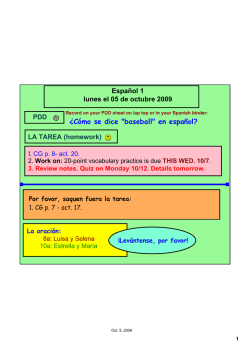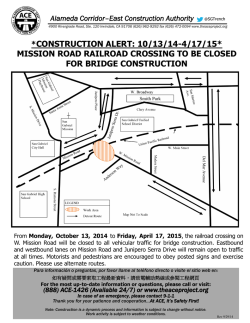
Fal - Stephen F. Austin State University
Stephen F. Austin State University Department of Languages, Cultures and Communication Span 131.006, MWF, 9:00-9:50 F179, - Fall 2015 Instructor: Kim Wells Office: LAN 254 Telephone: (936) 468-4303 or 468-2070 e-mail: [email protected]; [email protected] Office Hours: MWF from 11:00-12:00 and TR from 11:00 to 12:00 or by appointment when possible Text: Vistas, 5th Edition, + Supersite Plus WebSAM. Visit the online store to choose the format that you prefer. http://www.vhlcentral.com General Education Core Curriculum Objectives/Outcomes SPA 131: Three semester hour course which is a part of the Core Curriculum of the university and as such strives toward both the general goals of the core and the specific objectives as a communication course designated for inclusion in the Component Area Option as specified by the Texas Higher Education Board. In addition to helping students develop skills in speaking, listening, reading and writing in Spanish and providing them with a better understanding and appreciation for of Hispanic culture, SPA 131 will also demonstrate the more general ability to: Communicate effectively by developing and expressing ideas through written and oral communication. Think critically, which includes the ability to analyze, evaluate, and synthesize information about the history, culture, family, and artistic production of the Spanishspeaking world. Work as a part of a team, by demonstrating the ability to consider different points of view and to work effectively with others, supporting a shared purpose of goal. Understanding the role that personal responsibility has played throughout history and gain the ability to connect choices, actions, and consequences to making ethical decisions. Program Learning Outcomes: This is a general education core curriculum course and no specific program learning outcomes for this major are addressed in this course. General Education Core Curriculum: This course has been selected to be part of Stephen F. Austin State University’s core curriculum. The Texas Higher Education Coordinating Board has identified six objectives for all core courses: Critical Thinking Skills, communication Skills, Empirical and Quantitative Skill, Teamwork, Personal Responsibility, and Social Responsibility. SFA is committed to the improvement of its general education core curriculum by regular assessment of student performance on these six objectives. Assessment of these objectives at SFA will be based on student work from all core curriculum courses. This student work will be collected in D2L through LiveText, the assessment management system selected by SFA to collect student work for core assessment. LiveText accounts will be provided to all students enrolled in core courses through the university technology fee. You will be required to register your LiveText account, and you will be notified how to register your account through your SFA e-mail account. If you forward your SFA e-mail to another account and do not receive an e-mail concerning LiveText registration, please be sure to check your junk mail folder and your spam filter for these e-mails. If you have questions about LiveText, call EXT. 1267 or e-mail [email protected]. Core Objective Definition Critical Thinking Skills To include creative thinking, innovation, inquiry, and analysis, evaluation and synthesis of information. Communication Skills To include effective development, interpretation and expression of ideas though written, oral, and visual communication. Empirical and Quantitative Skills To include the manipulation and analysis of numerical data or observable facts resulting in informed conclusions. To include the ability to consider different points of view and to work effectively with others to support a shared purpose or goal. To include the ability to connect choices, actions and consequences to ethical decision-making. To include intercultural competence, knowledge of civic responsibility, and the ability to engage effectively in regional, national, and global communities. Teamwork Personal Responsibility Social Responsibility Course Assignment Title Date Due in LiveText Student Learning Outcomes: Students will be exposed to and actively engage in discussions regarding songs, comics, videos, news and internet materials, and readings from text that relate to the culture of Spanish speaking countries. Students will use vocabulary dealing with the following themes in their writing and speaking: greetings and leave-taking, expressions of courtesy, academic life, numbers, the calendar, time, interrogative words, weather, seasons, the family and physical traits and personality, the city and locations, pastimes and sports, colors, and clothing and shopping practices. Students will be able to correctly utilize the following grammatical structures: articles, gender and number of nouns, present tense, the implied future tense, adjective placement and agreement, ser and estar, -ar, -er and –ir verb conjugations, irregular present tense verb conjugations, direct and indirect object pronouns, the verb gustar and saber and conocer, and some of the preterite tense. Students will be able to communicate in oral and written form about what one normally does, where one lives, what one likes to do, vacations, shopping, and one’s family. Students will investigate very simple topics on the Internet in Spanish and record their findings. Assessment Assignment: To measure the success of student acquisition of these mandated skills, one assignment during the semester will require written and oral critical analysis of a film in the target language and selected readings, which will require that students think critically about the film and the historical background, examine how individual choices and decisions influenced the story, and consider the challenges faced by Latin Americans assimilating into U.S. culture. Completion of this assignment is required by the university and is an important component in the successful completion of this course. Further instructions will be provided at the appropriate time. Organization: This course will cover lessons 1-6 in Vistas and includes enrolling in a lab session. Students will be assigned readings, activities, and grammatical exercises to be completed before each class in order to practice the necessary skills in the target language during class time. Attendance and Participation: Attendance is mandatory. Using Spanish to interact with your instructor and other students in the class is an important aspect of learning the language and cannot be measured by written exams. Therefore a portion of the final grade will depend on class participation. Your participation grade is based on attendance, your attempts to communicate in Spanish whenever possible, regular preparation of all daily assignments, participation in paired and group activities, and arriving to class with all materials. All students are expected to participate actively speaking in Spanish during the class period. Since this class meets three times a week, you must study an adequate amount of time outside of class every day. Classroom attendance accompanied by 30 to 60 minutes of additional study time per day is recommended. Speaking English in class or disrupting the class in any way will result in a poor participation grade. Unexcused absences and tardies will also adversely affect participation averages. Late Work: No late work will be accepted without approval from your instructor and/or proper documentation is submitted from a university sponsor, physician, etc. For documented excused absences, you may make up quizzes and exams for classes missed. You are encouraged to discuss any missed assignments with your instructor. Make an appointment during office hours. Class Conduct: All pagers and cellular devices should be silenced during class. They must be put away at all times! University policy forbids bringing food or drink into the classroom so please refrain from doing so. Courteous behavior is expected at all times and includes being attentive and respectful to other students during class. Please do not leave class after completing a quiz. You may, however, leave quietly after completing an exam. Lab: The language lab is available to you to complete assignments for your class and to use as a resource center. Grading Criteria: Exams: 40% Tests / Oral Q-A /Compositions: 25% * Quizzes / Homework / Participation: 15% Lesson assessments: 5% Final Exam 15% A = 89.5 - 100 B = 79.5 - 89.4 C = 69.5 - 79.4D = 59.5 - 69.4 *Your lowest quiz and homework grades will be dropped. *Students must pass Spanish 131 with a 70 or higher to enroll in Spanish 132. Withheld Grades: Ordinarily, at the discretion of the instructor of record and with the approval of the academic chair/director, a grade of WH will be assigned only if the student cannot complete the course work because of unavoidable circumstances. Students must complete the work within one calendar year from the end of the semester in which they receive a WH, or the grade automatically becomes an F. If students register for the same course in future terms the WH will automatically become an F and will be counted as a repeated course for the purpose of computing the grade point average. Academic Honesty: Academic dishonesty, cheating and plagiarism will not be tolerated. All students in this class are expected to comply with university policies regarding academic honesty. Any student caught cheating will receive a grade of zero on the assignment and will be reported to the dean of his or her school. All homework should be done on your own. Students are not allowed to use translation programs, native speakers, LRC workers or other students to assist them with assignments. Doing so constitutes academic dishonesty and will be dealt with according to university policy. Academic integrity is the responsibility of all university faculty and students. Faculty members promote academic integrity in multiple ways including instruction on the components of academic honesty, as well as abiding by university policy on penalties for cheating and plagiarism. Definition of Academic Dishonesty: Academic dishonesty includes both cheating and plagiarism. Cheating includes but is not limited to (1) using or attempting to use unauthorized materials to aid in achieving a better grade on a component of a class; (2) the falsification or invention of any information, including citation, on an assigned exercise; (3) helping or attempting to help another in an act of cheating or plagiarism. Plagiarism is presenting the works or ideas of another person as if they were your own. Examples of plagiarism are; (1) submitting an assignment as if it were one's own work when, in fact, it is at least partly the work of another; (2) submitting work that has been purchased or otherwise obtained from an Internet source or another source; and (3) incorporating the works or ideas of an author into one's paper without giving the author due credit. Students with Disabilities: If you have a learning or physical disability, visual or hearing impairment that might affect your progress in Spanish, please see me. To obtain disability related accommodations, alternate formats and/or auxiliary aids, students with disabilities must contact the Office of Disability Services, (ODS), Human Services Building, and Room 325, 468-1004 (TDD) as early as possible in the semester. Once verified, ODS will notify the course instructor and outline the accommodation and/or auxiliary aids to be provided. Failure to request services in a timely manner may delay your accommodations. For additional information, go to http://www.sfasu.edu/disabilityservices/. Tentative Course Schedule for SPA 131 TB: Textbook: Vistas, 5th Edition; Please consult http://www.vhlcentral.com for specific homework and lab assignments related to class activities. M Aug31: Introducción al curso. TB: 1-5, Contextos: Hola, ¿Qué tal?; TB: 10-11, Cultura: Saludos y besos en los países hispanos, La plaza principal TB: 9, Pronunciación: The Spanish alphabet. Homework: Review and practice the alphabet and Greetings. Complete WebSAM assignments online. W Sep2: TB: 12-15, Estructura: Nouns and articles; TB: 19-23, Subject pronouns and present tense of SER, Use of HAY. Homework: Complete any practice exercises started in class and WebSAM assignments. F Sep4: TB: 16-18, Estructura: Numbers 0-30; TB: 24-27, Estructura: Telling time. Homework: Study vocabulary related to numbers and telling time, review formal and informal greetings, complete personal questions and WebSAM assignments. M Sep7: Labor Day, No class W Sep9: TB: 28-29, Recapitulación y repaso; Oral Q-A Homework: Study for test. F Sep11: Test 1. Homework: Study vocabulary for lesson 2 and complete WebSAM assignments. M Sep14: TB: 40-43, Contextos: En la universidad; TB: 59, Estructura: The present tense of ESTAR; TB: 47, Pronunciación: Spanish vowels. Tarea: Study vocabulary and review the conjugations of SER, ESTAR and HAY. Complete WebSAM and Personal Questions. W Sep16: TB: 50-54, Estructura: Present tense of –ar verbs. Tarea: Completar las preguntas personales, WebSAM, y estudiar los verbos. F Sep18: TB: 55-58, Estructura: Forming questions in Spanish; Review test. Tarea: Repasar el vocabulario y completer WebSAM. Practicar las preguntas con un amigo Estudiar “Prepositions of Place”. M Sep21: TB: 60-62, Estructura: ESTAR with prepositions of place, The verb GUSTAR. Tarea: Completar WebSAM y las preguntas personales con GUSTAR. W Sep23: TB: 63-65, Estructura: Numbers 31 and higher; Review of verbs to date. Tarea: Estudiar para el examen y completar WebSAM. F Sep25: TB: 66-67, Recapitulación; Repaso para el examen. Tarea: ¡Estudiar mucho! M Sep28: EXAM 1; Tarea: Estudiar el vocabulario de La familia y completar las preguntas personales y WebSAM. W Sep30: TB: 78-81, Contextos: La familia. Tarea: Practicar las preguntas personales con un amigo. F Oct2: Review exam; Oral Q-A. Tarea: Estudiar los adjetivos y completar WebSAM. Practicar las preguntas personales. Leer (Read) about descriptive and possessive adjectives and/or read online Powerpoint notes about same. M Oct5: TB: 88-92, Estructura: Descriptive adjectives; TB: 93-95, Estructura: Possessive adjectives. Tarea: Completar la práctica de WebSAM. Escribir párrafo sobre la familia. W Oct7: TB: 96-99, Estructura: Present tense of –er and –ir verbs. Tarea: Estudiar los verbos y completar las preguntas personales y WebSAM. F Oct9: TB: 100-103, Estructura: Present tense of TENER and VENIR. Tarea: Practicar las preguntas con un amigo y completar las preguntas personales y WebSAM. M Oct12: TB: 85, Pronunciación: Dipthongs and linking; TB: 104-105, Recapitulación; Repaso; Oral Q-A. Tarea: Estudiar para la prueba. W Oct14: Test 2. Tarea: Estudiar el vocabulario nuevo y responder a las preguntas personales F Oct16: TB: 116-119, Contextos: Los pasatiempos. Tarea: Repasar las preguntas personales y completar WebSAM. M Oct19: TB: 123, Pronunciación: Word stress and accents; Review test. Tarea: Leer sobre el verbo IR. W Oct21: TB: 126-128, Estructura: Present tense of the verb ir. Tarea: Completar la tarea con el verbo IR y WebSAM. Estudair los verbos de cambio radical (stem changing verbs). F Oct23: TB: 129-132, Estructura: Stem changing verbs e-ie, o-ue; TB: 133-135, Estructura: Stem changing verbs e-i. Tarea: Completar la práctica y las preguntas personales con los verbos de cambio radical y WebSAM. M Oct26: TB: 136-139: Estructura: Verbs with irregular yo forms. Tarea: Completar la práctica con los verbos y WebSAM. Estudiar y repasar todos los verbos. W Oct28: TB: 140-141: Recapitulación; Review verbs to date. Estudiar para el examen. F Oct30: EXAM 2; Tarea: Estudiar el nuevo vocabulario de Contextos, completar las preguntas personales y WebSAM. M Nov2: TB: 152-157, Contextos: Las vacaciones. Tarea: Practicar las preguntas personales con un amigo. Repasar los usos de ESTAR. W Nov4: Review exam 2. Tarea: Repasar todo el vocabulario. F Nov6: TB: 164-165, Estructura: Estar with conditions and emotions. Tarea: Estudiar los usos de ESTAR. Leer la formación del presente progresivo. M Nov9: TB: 166-169, Estructura: The present progressive. Tarea: Completar las preguntas y la práctica y completar la tarea de WebSAM. W Nov11: TB: 170-173: Estructura: Ser and estar. Tarea: Repasar todos los usos de SER y ESTAR y completar la práctica y WebSAM. F Nov13: TB: 174-177: Estructura: Direct object nouns and pronouns. Tarea: Estudiar y practicar con los pronombres y completar la tarea de WebSAM. M Nov16: TB: 162, Pronunciación: spanish b and v; Direct object nouns and pronouns. Tarea: Estudiar para el examen y repasar las preguntas de Contextos. W Nov18: TB: 178-179, Recapitulación; Review; Oral Q-A. Tarea: Estudiar para la prueba. F Nov20: Test 3. Tarea: Estudiar el vocabulario de Contextos, completar las preguntas personales. M Nov23: TB: 190-193, Contextos: ¡De compras!; TB: 197: Pronunciación: The Spanish d and t; Review test. Tarea: Practicar las preguntas personales con un amigo y completar la tarea de WebSAM. W Nov 25 and F Nov 27, Thanksgiving Holiday, No classes. As much as I would love to say just relax, this would be a good time to go back and review lessons from beginning of the semester. M Nov30: TB: 200-201, Estructura: Saber and conocer; TB: 202-205, Estructura: Indirect object pronouns. Tarea: Completar la práctica y WebSAM. Leer sobre el pretérito. W Dec2: TB: 206-209, Estructura: Preterite of regular verbs. Tarea: Aprender las terminaciones para el pretérito de los verbos, completar las preguntas personales y la práctica de WebSAM. F Dec4: TB: 210-213, Estructura: Demonstrative adjectives and pronouns. Tarea: Aprender los adjectivos demostrativos, repasar el pretérito, y completar WebSAM. M Dec7: TB: 214-215, Recapitulación; Review; Oral Q-A. Tarea: Repasar para el examen final. W Dec9: Review for final exam; Oral Q-A. Tarea: Repasar para el examen final. F Dec11: Review for final exam; Oral Q-A. Tarea: Repasar para el examen final. Final Exams: Dec 14-18
© Copyright 2025

